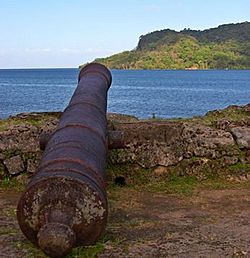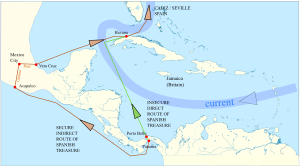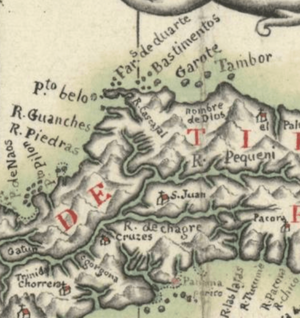Blockade of Porto Bello facts for kids
Quick facts for kids Blockade of Porto Bello |
|||||||
|---|---|---|---|---|---|---|---|
| Part of the Anglo-Spanish War (1727–1729) | |||||||
 View across Porto Bello harbour entrance, looking NW from Fort Santiago |
|||||||
|
|||||||
| Belligerents | |||||||
| Commanders and leaders | |||||||
| Strength | |||||||
| 11 ships of line 1 frigate 2 sloops of war 1 snow 4,750 men |
2,000 troops | ||||||
| Casualties and losses | |||||||
| 4,000+ dead 1 ship wrecked |
|||||||
| Most British casualties were due to yellow fever and other tropical diseases. | |||||||
The Blockade of Porto Bello was a time when the British navy tried to stop Spanish ships from leaving the port of Porto Bello in what is now Panama. This happened between 1726 and 1727 during the Anglo-Spanish War. The British wanted to stop the valuable Spanish treasure fleet from sailing to Spain. However, many British sailors got sick from tropical diseases. This forced the British ships to leave and get new crews. While they were gone, the Spanish treasure ships managed to escape.
Contents
Why Did the Blockade Happen?
Spain and Britain had disagreements in the 1720s, especially about trade. They had recently fought in the War of the Quadruple Alliance. Britain was also worried that Spain might team up with Austria to declare war on Britain and its ally, France.
To weaken Spain, Britain decided to stop the treasure fleets. Spain depended on these fleets for money. In March 1726, a British navy group was sent to the Spanish West Indies. Their job was to block or capture Spanish galleons carrying treasure.
A former privateer named Woodes Rogers knew a lot about these routes. He advised the British government on how the Spanish might try to get their treasure home. He explained that it would be very hard for Spanish ships to go around Cape Horn with heavy cargo. He thought it was more likely the treasure would go from Panama to Acapulco, then overland to La Vera Cruz, and finally by sea to Havana before sailing to Spain.
The Blockade in Action
On June 16, 1726, the British fleet, led by Rear-Admiral Francis Hosier, arrived near Bastimentos. This island was about 11 kilometers (7 miles) from Porto Bello. The British were ordered to block the port but not to attack it directly. Hosier's ships stayed in front of Porto Bello, checking all ships that tried to enter or leave. They captured several Spanish ships when they first arrived. The Spanish treasure convoy unloaded its valuable cargo and waited safely in the port.
After six months, a terrible tropical disease, yellow fever, spread among the British sailors. So many men got sick and died that Hosier had to take his fleet to Jamaica to get new crews.
This break in the blockade allowed the Spanish to act. In January 1727, Antonio de Gaztañeta managed to sneak a Spanish treasure fleet out of Porto Bello. This fleet carried 31 million pesos and reached Spain safely on March 8, 1727.
The Terrible Sickness
The yellow fever spread quickly because of poor hygiene on the British ships. Out of about 4,600 British sailors, between three and four thousand died from the disease. Admiral Hosier himself died of yellow fever on August 23, 1727. His body was kept on his ship for four months before it could be sent back to England for burial.
After Hosier's death, Edward St. Lo took command. He continued the blockade but also had to return to Jamaica for supplies. In January 1728, Edward Hopson replaced him, but Hopson also died from disease in May. St. Lo then took command again. He led the fleet until April 1729, when he too died from a tropical illness.
By this time, Britain and Spain had agreed on peace terms. The war officially ended with the Treaty of Seville in November 1729. The British fleet then returned home.
British Fleet Ships
The British fleet had about 20 ships. Some of the main ones included:
- HMS Breda, a 70-gun ship and the flagship
- HMS Berwick, a 70-gun ship
- HMS Lenox, a 70-gun ship
- HMS Superb, a 64-gun ship
- HMS Dunkirk, a 60-gun ship
- HMS Nottingham, a 60-gun ship
- HMS Rippon, a 60-gun ship
- HMS Portland, a 50-gun ship
- HMS Leopard, a 50-gun ship
- HMS Tiger, a 50-gun ship
- HMS Dragon, a 50-gun ship
- HMS Diamond, a frigate
- HMS Greyhound, a sloop
- HMS Happy (or Return), a snow (a type of ship)
What Happened Next?
The failure of the blockade and the huge loss of life caused a big public outcry in Britain. Admiral Hosier was blamed for not doing enough. However, his actions were limited by orders from Robert Walpole, who wanted to avoid a full-scale war with Spain.
Years later, at the start of the War of Jenkins' Ear (1739–42), the disaster at Porto Bello was still remembered. When Admiral Vernon successfully captured Porto Bello in 1739 with only six ships, the British public was overjoyed. This event even inspired the famous song Rule, Britannia!
The poet Richard Glover wrote a ballad called Admiral Hosier's Ghost. This poem further stirred up feelings against the Spanish. It also aimed to criticize Walpole and those who opposed war, suggesting their orders had betrayed Hosier and his men.
See also
 In Spanish: Bloqueo de Portobelo para niños
In Spanish: Bloqueo de Portobelo para niños





